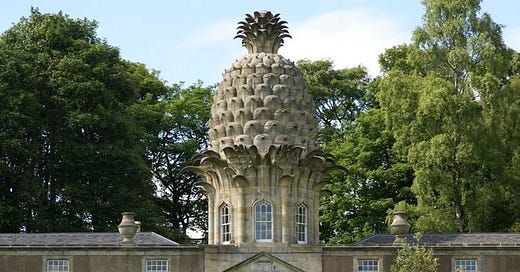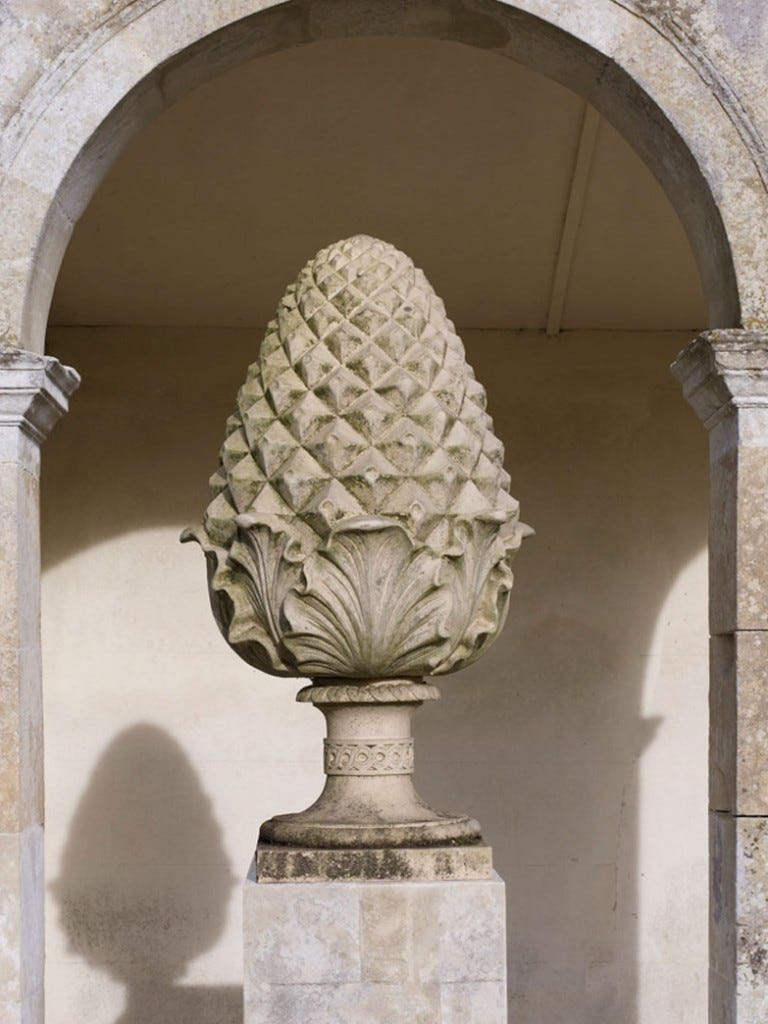What’s with the Georgian fascination for pineapples? And why do we see them everywhere?
This luxury fruit was first imported to Europe in 1496 by Christopher Columbus but it took until the eighteenth century before it could be grown at home and more easily consumed.
But to grow them was no easy feat. They required specialist Hot Houses, expensively heated 24 hours a day all year round, and so became synonymous for luxury, opulence and excellence.
Even the playwright Richard Brinsley Sheridan put a reference in his 1775 play The Rivals, with Mrs Malaprop delightfully exclaiming:
“Sir, you overpower me with good-breeding.—
He is the very pine-apple of politeness!”
Costing thousands of pounds to grow or purchase, having one of these pride of place in the centre of your dining table was the ultimate status symbol.
It showed you could afford to either purchase or, even better, grow them yourself. And failing that, you could even rent one to keep up appearances.
For the desperate, stealing pineapples was a serious offence, and could result in being transported to the colonies for seven years. So instead the middling and aspiring classes could make do and show their gentility and taste by purchasing one of the many pineapple themed objects available in the eighteenth century. Teapots, jelly moulds, ewers, clocks, paintings, tureens, purses, wallpaper, bowls, cups, sugar shakers, chairs, curtains…the list goes on. My personal favourite is this wonderfully eccentric Wedgwood tea set.
For me however, I’ll carry on visiting British country houses and playing the simple game of Spot the Pineapple. It’s easy to do and once you start looking, you’ll notice they regularly appear in Georgian architecture and fine art.
It’s fascinating to reflect on the relatively short-lived fashion for pineapples as status symbols and yet their long-standing legacy in our art and architecture. What will be our pineapple equivalent for future generations? Apparently the most expensive fruit on sale today is the Yubari King Melon from Japan which sells for hundreds if not thousands of pounds. But I can’t see that becoming our modern-day pineapple…Status symbols of supercars, fine art, designer fashion and luxury real estate maybe? But they all seem so transitory. I guess that’s rather the point though.
And that makes me conclude that if someone two hundred years from now were to look back at our contemporary art and architecture I believe they would see our passion for sustainability. We now strive for minimising our impact on the natural world in new projects. We seek to reduce our waste and energy usage, and repurpose older structures and items. There’s even a project now to reuse natural fibres from pineapple plants to create a sustainable alternative to leather for clothes, bags and shoes. So I truly hope that people in the future, instead of noticing one specific fashionable status symbol reflected across our culture, they will see our varied and optimistic attempts at creating ecological resilience threaded through our contemporary art and architecture instead.








